Mobile:+86-311-808-126-83
Email:info@ydcastings.com
Affordable Stainless Steel Casting Prices - Quality Metal Solutions
Understanding the Price of Stainless Steel Casting
Stainless steel casting is a critical process in manufacturing various components used across numerous industries, including aerospace, automotive, medical, and construction. As the demand for durable, corrosion-resistant materials continues to grow, understanding the factors influencing the price of stainless steel casting becomes essential for manufacturers and buyers alike.
Factors Influencing Price
1. Material Cost The primary component of stainless steel casting is, of course, stainless steel itself. The price of stainless steel can vary significantly based on market fluctuations, raw material availability, and global demand. Alloying elements such as nickel, chromium, and molybdenum also impact the cost, with higher percentages leading to increased prices.
2. Design Complexity The complexity of the design plays a crucial role in determining the casting price. More intricate designs may necessitate specialized molds and more extensive labor, leading to higher costs. Conversely, simpler designs usually result in lower production expenses.
3. Casting Method Different casting methods—such as investment casting, sand casting, and die casting—have varied cost implications. Investment casting, for example, often yields higher precision and better surface finishes but typically comes at a higher cost than sand casting due to the additional steps required in the process.
4. Production Volume When it comes to pricing, economies of scale can significantly influence cost. Bulk orders typically reduce the per-unit price due to lower setup costs and more efficient use of materials and labor. On the other hand, small orders may bear a higher per-unit price because the fixed costs are spread over fewer pieces.
stainless steel casting price

5. Finishing Processes After casting, additional processes such as machining, polishing, or coating can affect the final price. These finishing touches are often necessary to ensure the components meet specific performance and aesthetic standards, but they add to the overall production cost.
6. Geographic Factors The location of manufacturing facilities also plays a role in pricing. Regions with higher labor costs or stringent environmental regulations may see increased casting prices due to elevated operational expenses. Conversely, countries with lower labor rates may offer more competitive pricing.
Market Trends
The stainless steel casting market has witnessed fluctuations influenced by global trends, such as shifts in supply chains and changes in consumer demand. Post-pandemic economic recovery has led to a rebound in manufacturing activities, impacting raw material prices. Additionally, as sustainability becomes more prominent, there is a growing interest in recycled stainless steel, which can alleviate price pressures associated with traditional raw materials.
Conclusion
In summary, understanding the price of stainless steel casting is multifaceted, reflecting the interplay of material costs, design complexity, production methods, and market dynamics. For businesses involved in procurement or manufacturing, keeping abreast of these factors is vital to making informed decisions that align with both budgetary constraints and quality requirements. As the industry progresses, staying updated on market trends and pricing metrics will be key to optimizing costs in the ever-evolving landscape of stainless steel casting.
-
Understanding Metal Casting TechniquesNewsApr.02,2025
-
Understanding Exhaust Manifolds for Enhanced Engine PerformanceNewsApr.02,2025
-
The World of Metal FabricationNewsApr.02,2025
-
Key Components for Pump and Turbo EfficiencyNewsApr.02,2025
-
Essential Tools for Automotive Maintenance and RepairNewsApr.02,2025
-
Durable Valve Components for Effective Water ManagementNewsApr.02,2025











